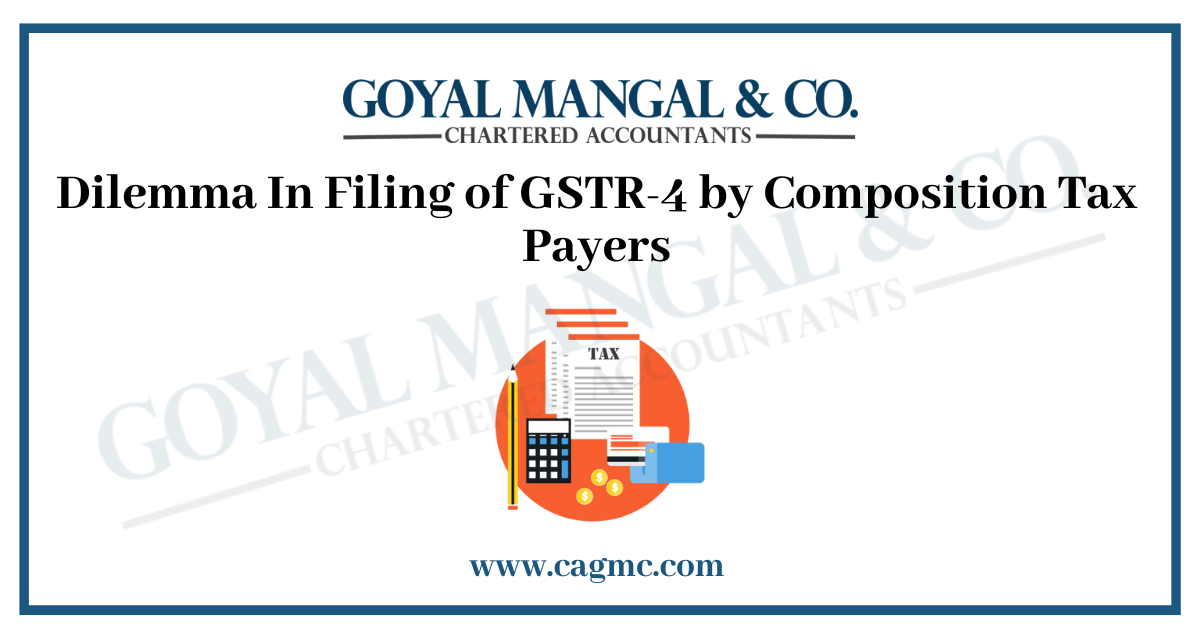
The Composition Scheme was introduced by small taxpayers with the aim of providing relief from the complex and difficult process imposed by ordinary taxpayers. Section 10 of the CGST Act defines the eligibility criteria for registration as a taxpayer. A clear reading of section 10 and appropriate rules that have been revised several times will show how difficult it is for a small taxpayer to understand the basic provisions. This article focuses on the dilemma in filing of GSTR-4 by composition tax payers.
|
Table of content |
What is GSTR-4?
Form GSTR-4 is the annual return form for those taxpayers who have opted for the GST Composition for a new indirect tax system. Under the GST naming system, taxpayers will be required to complete only one return for each financial year. Also, taxpayers will need to file CMP-08 to receive quarterly payments. The deadline for each completion of CMP-08 is the 18th for each subsequent term.
Negative liability in GSTR-4
Circumstances have been observed when taxpayers report bad debt from their GSTR-4.
- Background: From FY 2019-20, taxpayers must pay off debt in Form GST CMP-08 by quarterly while GSTR-4 Return is required to be filed annually after the end of the financial year.
- Reason for Bad Liability in GSTR4: Full-year credit needs to be announced in GSTR-4 below applicable tax rates. Taxpayers are required to complete GSTR-4 Table 6 by default. If it does, there is no case, the table may be filled with the number ‘0’. If no debt is declared in Table 6, it is assumed that no debt is incurred required to pay, however, the taxpayer may pay the debt in Form GST CMP-08. In such cases, Debt paid with GST CMP-08 becomes more taxable and moves to Bad Debt Statement the same expenditure on the debt for the next tax period.
- Improper Taxpayer Activity: Debt payable on Form GST CMP-08 is automatically completed in Table 5 GSTR-4 for the convenience of taxpayers. Taxpayers who do not complete table 6 of GSTR-4 i.e. no credit specified, however, the taxpayer may pay the debt in Form GST CMP-08; as ‘Taxes’ on GSTR-4 is computed after reducing the debt declared in GST CMP-08 and automatically completed in table 5. So, if nothing else is announced in Table 6, and the negative credit induction comes from GSTR-4.
- How to proceed if there is a legal obligation: If table 6 of GSTR-4 is not completed due to oversight, ticket may be collected to eliminate the amount found in the negative credit statement. If there is no debt to be paid on time annually, the debt payable on Form GST CMP-08 will extend to a negative and similar credit statement the excess amount can be used to pay off debt for future tax periods.
Reason of negative liability in GSTR-4
Full-year credit needs to be declared in GSTR-4 below applicable tax rates. Taxpayers are required to provide information in Table 6 of Form GSTR-4 as compulsory. In the event that there is no debt, Table 6 of Form GSTR-4 can be completed with a value of ‘0’. If no debt is declared in Table 6, it is assumed that no debt is required to be paid, though; the taxpayer may pay the debt in Form GST CMP-08.
Reason for composition dealers facing dilemma in filing the GSTR-4
Debt payable on Form GST CMP-08 is automatically completed in Table 5 of GSTR-4 for the convenience of taxpayers. Taxpayers who do not complete GSTR-4 table 6 i.e. no debt has been declared, however, the taxpayer is likely to pay off the debt in Form GST CMP-08; as ‘Taxes’ on GSTR-4 are calculated after deducting the debt declared in GST CMP-08 and automatically filling in table 5. So, if nothing is announced in Table 6, then the negative credit rating comes from GSTR-4.
Procedure to Rectify and Steps to Nullify Negative Liability Adjustment
Although the government will not provide any assistance or remedy in this regard, the aggrieved taxpayer may write to the official GST official or issue a ticket to the petition as soon as the matter comes to him or her as a first step.
In addition to the above action, the taxpayer may also consider the immediate solutions listed below. The solution varies depending on the situation as follows:
- If Table 6 of GSTR-4 is not completed due to surveillance, a ticket may be raised to eliminate the amount found in the negative credit statement.
- If there is no debt to be repaid during the year, the debt payable on Form GST CMP-08 will extend to the negative credit statement and the same excess amount may be used to settle future tax debt.
Conclusion
The deadline for completing the GSTR-4 should be the same as the date for completing the GSTR-9 or otherwise should be amended accordingly. The obligation to pay taxes is due to the technical problems of the portfolio which should be resolved without further delay.


